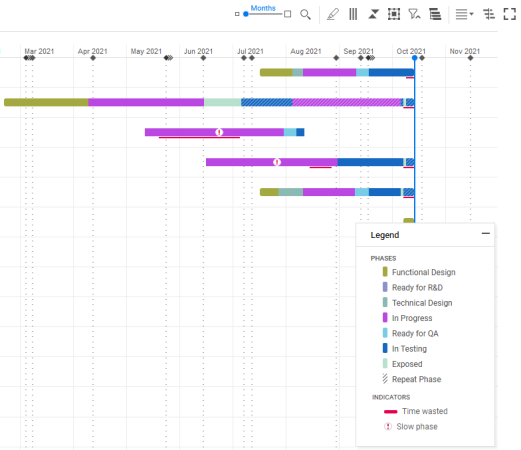Timeline view
Use the timeline to track and analyze a release's progress and its quality.
Overview
The timeline displays features, epics, and other backlog items in a Gantt chart.
Visual representation of the item phases helps you analyze the current release by identifying:
- Long phases that may imply delays or bottlenecks.
- Phase slowdown in relation to its average cycle time.
- Repeated phases that may imply rework.
- Waste time that may imply waiting, unnecessary motions, overprocessing, or any other waste defined by your process team.
The items' timeline is available in the following views:
- Grid view
- Slim Grid View
To view the timeline, on the Features, Epics, or Backlog items tabs, select Show Timeline  .
.
For details, see Views.
Timeline bars
In the timeline view, the bars represent items in different phases between the New and Done metaphases. This means that an item's timeline starts when the item reaches the In Progress metaphase, and ends when the item reaches metaphase Done. The New and Done metaphases are not represented in the timeline.
Tip: Hover over a section of the bar, marked with a certain color, to view an item's details, such as a phase the color represents, the phase start and end date, waste time, as well as the item's cycle time for that phase.
Timeline bars are constructed as follows:
| Bars | Details |
|---|---|
| Color |
The bar colors represent an item's different phases between the New and Done metaphases. The colors reflect phases configured for the item workflow, and may be different depending on an item type. If an item's phase is repeated, the phase bar is marked with diagonal stripes additionally to the phase color. Tip: Check the legend in the lower-right corner for phase-specific color representations. |
| Red line for waste |
If waste tracking for an item type is configured, the waste time is represented by a red line under the item bars whose phases are associated with waste. For details, see Track waste. |
| Position and length |
The bars' position represents the following: Start point: The date on which an item moved into a starting phase of the In Progress metaphase, for example phase Functional Design. End point: The date on which an item moved into a starting phase of the Done metaphase. The bar's length is determined by the time an item spent in all the phases between the New and Done metaphases. Note: The timeline displays the calendar start and end dates, while the Cycle time and Waste fields exclude the non-working days. |
Timeline legend
The timeline legend provides colors that represent an item's phases between the New and Done metaphases, and includes the red line that represents waste.
The legend colors reflect phases configured for the item workflow, and may be different depending on an item type.
Available in 16.2.100 and later:
-
Drag and drop the legend within the timeline area.
-
The Feature's milestone indicator shows you the milestone of each feature on the feature's progress bar, to help you see if the feature will be done on time. The All milestone indicator shows milestones at the top of the timeline view.
-
You can show or hide different indicators from the timeline, using the eye icon
. For example, if you prefer to not see all milestones but only feature milestones, click the eye next to Indicators > All milestones to hide them from the view. This can help you focus on areas that are more relevant to your work.
Note:
- In the features timeline, the legend relates to features only. If features are grouped by epics, hover over an epic's bar in the timeline to view the epic's phase or other details. You can also expand an epic to view the bars for its features in the timeline.
- In the backlog items' timeline, the legend provides phase colors for each item type separately.
Milestones and the current date
Milestones and the current date are displayed as vertical lines along the timeline.
Available in 16.2.100 and later: Click Today in the upper right area above the timeline to jump to the current date.
| Vertical line type | Represents |
|---|---|
| Vertical blue line | The current date |
| Dotted vertical line |
Milestone The milestone types are distinguished by the diamonds at the top of the lines:
Hover over the lines to display the milestone details. |
Note: By default, the timeline displays only items that are related to a specific release. In the features grid, you can display all the items by clicking Show also indirect features at the bottom right of the pane. To revert to the original view, click Show only direct features. For details, see Connected items.
Timeline actions
You can perform the following actions in the timeline area:
| Action | Method |
|---|---|
| Zoom in or out of timescale |
Timescale slider or Ctrl + mouse wheel. |
| Display item details, such as phase, start and end date, cycle time, and waste (if configured) | Hover over the timeline bar. |
| Display milestone details | Hover over a milestone line. |
| Resize the timeline |
Hover over the divider between the grid and the timeline. When the two-headed arrow cursor appears, move the divider horizontally. |
If you are using a touchpad:
| Action | Method |
|---|---|
| Zoom in or out of timescale | Two-finger pinch in or stretch out. |
| Scroll along the timeline | Two-finger scroll. |
| Resize the timeline | Hover over the divider and press in the touchpad's lower-left corner. Then, drag the divider to the left/right. |
 Next steps:
Next steps:













